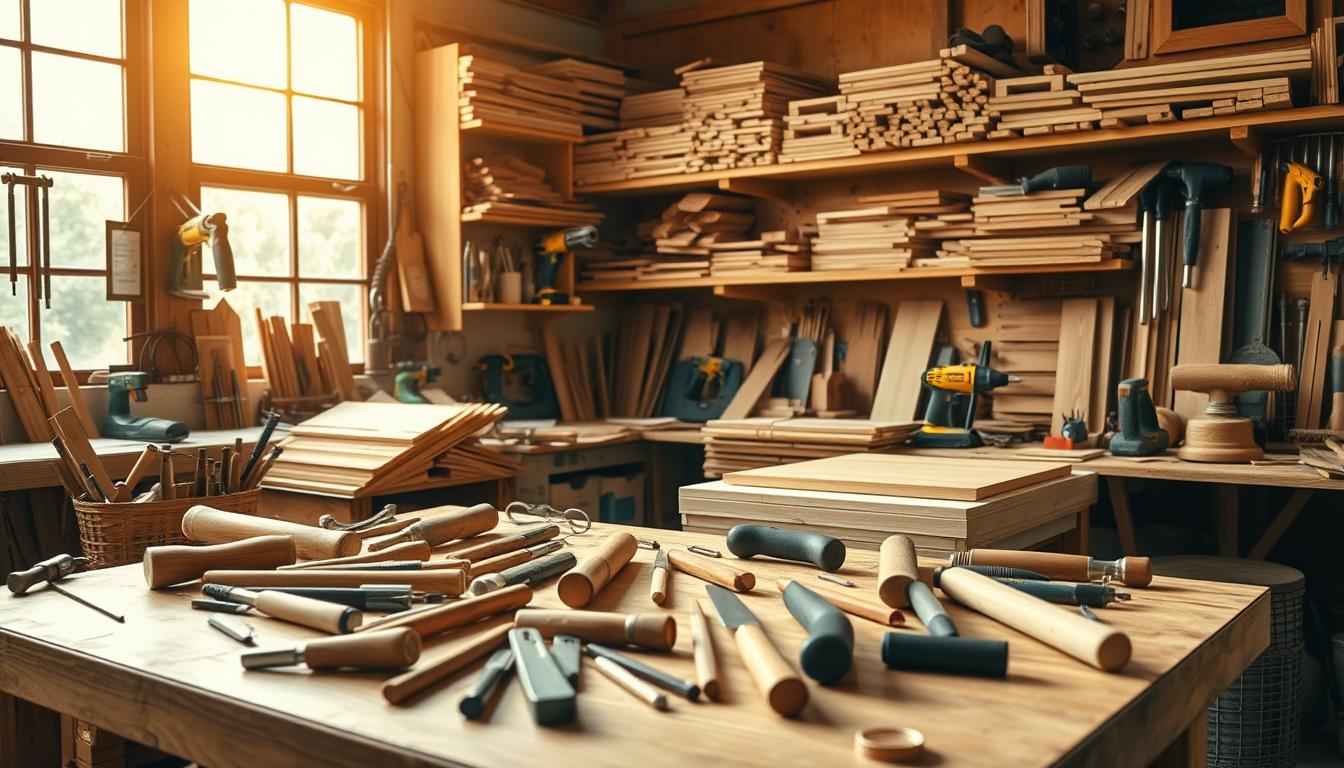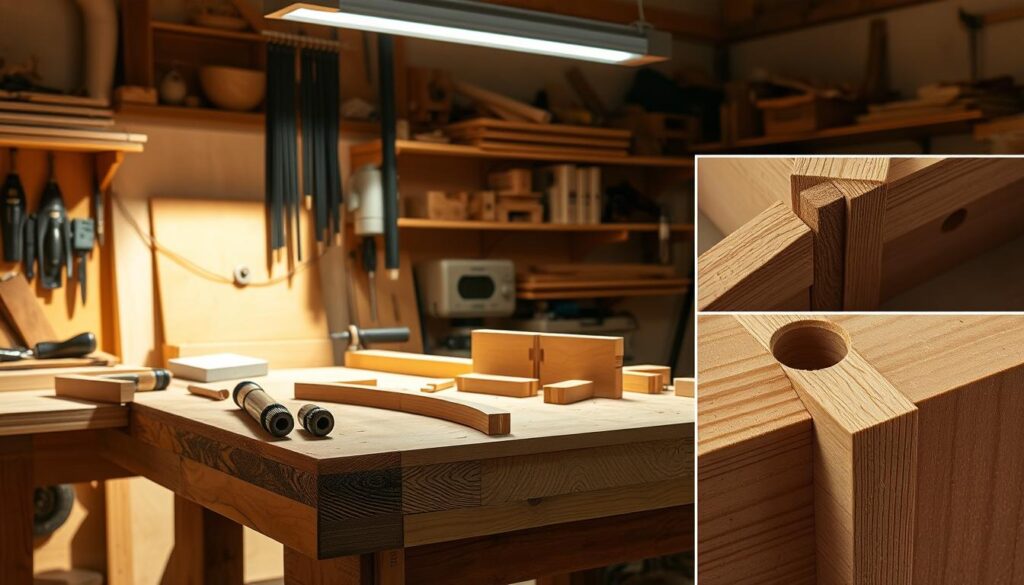Physical Address
304 North Cardinal St.
Dorchester Center, MA 02124
Physical Address
304 North Cardinal St.
Dorchester Center, MA 02124

Master essential carpentry tips to elevate your woodworking skills. Discover 15 expert-approved Carpentry Tips every DIYer should know.
As you embark on your woodworking journey, you’ll discover that mastering essential carpentry tips can elevate your skills and lead to more professional-looking DIY carpentry projects, and with the right woodworking advice, you can create beautiful and functional pieces1. Whether you’re a beginner or an experienced woodworker, understanding your tools and how to maintain them is crucial for success in woodworking. A general-purpose chisel is often ground at 25° and honed at 30°, which is a common practice among woodworkers1.
With the right carpentry tips and woodworking advice, you can improve your craft and create stunning pieces. The actual dimensions of a “2×4” board are 1.5 inches x 3.5 inches, not the nominal size of 2 inches x 4 inches, reflecting a reduction due to planing2. Additionally, 99% of woodworkers recommend the use of safety glasses for eye protection while operating woodworking machinery3.
As you begin your carpentry journey, it’s essential to understand the tools you’ll be working with. Mastering carpentry techniques requires familiarity with various tools, including hand saws, circular saws, and claw hammers4. Developing essential carpentry skills takes time and practice, but with the right tools and mindset, you can become proficient in no time4.
A well-organized workstation is crucial for productivity and motivation. Consider factors like cleanliness, lighting, ventilation, and comfort when setting up your workspace4. For beginner carpentry tips, it’s recommended to start with basic and cost-effective wood species like pine4. Accurate measurements are critical, and a single wrong measurement can potentially ruin an entire project4.
Investing in training, such as taking a woodworking course, can help you learn essential carpentry skills like sanding, cutting, and finishing4. Mastering carpentry techniques can take significant time and effort, but starting with smaller projects can help you build confidence and ability4. Remember to always use your tools safely and effectively, and don’t hesitate to seek guidance if you’re unsure about any beginner carpentry tips5.
When it comes to woodworking advice, one of the most critical aspects is mastering wood selection. This involves identifying quality wood types and understanding the importance of wood grain and texture in DIY carpentry projects. For instance, the type of wood used can significantly impact the durability and aesthetic appeal of a project, making it essential to choose the right wood for your woodwork tutorials.
A key factor in wood selection is the moisture content, which should ideally be below 20% for stable performance6. Additionally, considering the Golden Ratio, approximately 1:1.618, can enhance design aesthetics in woodworking projects6. By following these guidelines and tips, you can ensure that your woodworking projects turn out professional and of high quality.
Some wood species, like oak, are known for their strength and are often used for furniture, while softer woods like pine are more prone to dents6. Regular maintenance of tools can also improve their lifespan by over 50% and ensures better quality work6. By mastering wood selection and following these tips, you can create beautiful and durable DIY carpentry projects that reflect your skills and attention to detail.
For example, fast-growing oak posts used for ladderback chairs exhibit around 6 growth rings and have a specific diameter of 1¼”7. This highlights the importance of understanding wood characteristics when selecting wood for your projects. By applying the right woodworking advice and techniques, you can achieve professional-looking results in your woodwork tutorials and DIY carpentry projects.
| Wood Type | Characteristics | Suitability |
|---|---|---|
| Oak | Strong, durable | Furniture, construction |
| Pine | Soft, prone to dents | Decorative items, crafting |
By considering these factors and following expert woodworking advice, you can master wood selection and create stunning DIY carpentry projects that showcase your skills and creativity.
When it comes to essential carpentry skills, measuring is a crucial aspect that can make or break a project. As a beginner, it’s essential to learn beginner carpentry tips, such as measuring twice and cutting once, to avoid errors and ensure accuracy8. Advanced carpentry tricks, such as using a caliper for detailed measurements, can also help take your projects to the next level.
Using the right tools, such as a carpenter’s square, can enhance accuracy by 15-25% compared to a standard try square9. Additionally, utilizing hard pencils for marking joints can increase marking precision by around 20%9. Properly prepared components should be flat and square, as failure to achieve this can lead to a joint fitting failure rate of over 30%9.
To improve measurement accuracy, consider the following tips:
By mastering essential measuring techniques and incorporating beginner carpentry tips and advanced carpentry tricks into your workflow, you can ensure that your projects are accurate, precise, and of high quality89.
When working on DIY carpentry projects, safety should always be your top priority. According to statistical data, carpentry accidents and injuries can occur at a rate of approximately 25 per 100,000 workers annually10. To minimize the risk of injury, it’s essential to follow top woodworking tips and use proper safety gear. This includes wearing protective eyewear, gloves, and a dust mask when working with power tools.
Woodwork tutorials often emphasize the importance of maintaining a clutter-free workspace to decrease the likelihood of trip and fall accidents. In fact, regular cleaning and organization can reduce the risk of trips and falls by up to 50%11. Additionally, using ergonomic tools can reduce the risk of repetitive strain injuries by as much as 75%10.
To ensure a safe working environment, consider the following safety tips:

By following these safety tips and using proper safety gear, you can minimize the risk of injury and ensure a successful DIY carpentry project. Remember to always prioritize safety and follow top woodworking tips to get the best results.
| Safety Tip | Benefit |
|---|---|
| Wearing proper PPE | Reduces the risk of eye injury by up to 90%10 |
| Maintaining a clutter-free workspace | Decreases the likelihood of trip and fall accidents by 50%11 |
| Using ergonomic tools | Reduces the risk of repetitive strain injuries by as much as 75%10 |
When it comes to woodworking, planning and designing your projects is crucial for success. This is where you can apply essential carpentry skills, such as measuring and selecting the right materials, to ensure your project turns out as desired. With proper planning, you can avoid common pitfalls and create a beautiful, functional piece of furniture or other wooden item. According to statistical data, most woodworking projects are a combination of solid wood and veneer over substrate, indicating the need for careful material selection12.
Effective planning can enhance the quality of work, resulting in lifetime satisfaction for clients13. To achieve this, it’s essential to consider factors such as wood moisture content, tool selection, and design iterations. Successful design iterations often involve 3 to 5 thumbnail drawings before finalizing the woodworking plans, as visualizations are critical for accuracy12. By taking the time to plan and design your project carefully, you can avoid wasting time, money, and materials, and ensure that your final product meets your expectations.
Some key considerations for planning and designing your projects include:
By following these tips and applying essential carpentry skills, such as carpentry techniques and woodworking advice, you can create a beautiful and functional piece of furniture or other wooden item that will last for years to come.
Remember, planning and designing your projects is an essential part of the woodworking process, and can make all the difference in the quality of your final product. With careful planning and attention to detail, you can create a piece that you can be proud of, and that will provide years of enjoyment and use. Up to 40% of woodworking projects face delays due to improper tool selection or availability during the planning phase, emphasizing the importance of early tool determination12.
As you progress in your carpentry journey, mastering joinery techniques is essential for creating strong and durable joints. With various methods to choose from, it’s crucial to understand the basics of each technique. For instance, the butt joint is the most basic wood joinery technique, commonly utilized in wall framing on construction sites14. In contrast, mitered butt joints are often preferred for their aesthetic appeal despite their weaker structural integrity compared to butt joints14.
When it comes to choosing the right joinery method, consider the type of project you’re working on and the level of strength required. For example, the half-lap joint, while slightly stronger than a butt joint, compromises some strength due to the removal of half the thickness from both boards being joined14. On the other hand, the tongue and groove joint provides a significantly stronger connection with increased surface area for glue adhesion compared to basic butt joints14.
Some popular joinery methods for beginners include:
* Pocket screws
* Dowels
* Biscuit joints
* The Beadlock system15
These methods offer a range of benefits, including ease of use and cost-effectiveness. For example, a basic pocket hole kit can be purchased online for approximately $4015.
By mastering these joinery techniques and choosing the right method for your project, you’ll be able to create strong and durable joints that will last for years to come. Whether you’re a beginner looking for beginner carpentry tips or an advanced woodworker seeking advanced carpentry tricks, understanding joinery techniques is essential for any woodwork tutorials14.

When it comes to DIY carpentry projects, the finishing techniques can make or break the overall look and durability of the wood. Top woodworking tips include choosing the right finish for your wood, as different types of wood require specific techniques16. For example, oak and cherry wood require special care to enhance their aesthetic appeal and durability. Expert woodworkers recognize that a quality finish not only improves the visual aspect but also creates a protective barrier against environmental factors16.
In order to achieve a professional-looking finish, it’s essential to follow top woodworking tips, such as sanding and reapplying finishes regularly16. This can be done using various techniques, including staining, varnishing, and lacquering. Stains are commonly used to add color and allow natural grain visibility, while varnishes offer a versatile finish that can be glossy, matte, or satin16. Additionally, using the right tools, such as a random orbital sander, can help achieve a smooth finish17.
Some key carpentry techniques to keep in mind when finishing your DIY carpentry projects include using the right grit sandpaper, such as 80-grit or 120-grit, and applying light pressure to avoid swirly scratches17. It’s also important to choose the right brush for the job, as a good-quality brush can significantly improve the finish quality17. By following these top woodworking tips and using the right carpentry techniques, you can achieve a professional-looking finish that will enhance the beauty and durability of your wood.
Some other finishing techniques to consider include using a three-container system for cleaning brushes, which can save time and mineral spirits17. Additionally, using a pad on large areas can allow for faster application of water-based polyurethane, which dries quickly17. By incorporating these carpentry techniques into your DIY carpentry projects, you can achieve a professional-looking finish that will last for years to come.
As your carpentry journey continues, you may encounter a variety of challenges along the way. Whether it’s misaligned joints, warping wood, or cracking finishes, having the right troubleshooting skills can make all the difference18. Carpenters often face issues like glue stuck on wood, dents, and weak joints, which can compromise the structural integrity of your projects18. By learning how to address these common problems, you’ll be well on your way to creating long-lasting, professional-grade results.
One of the keys to successful troubleshooting is understanding the root causes of the issues you face19. Inaccurate measurements, improper installation techniques, and poor material selection can all lead to problems like misaligned frames, uneven joints, and floor sagging19. By mastering the essential carpentry skills covered in this article, you’ll be better equipped to identify and resolve these challenges20.
Remember, even the most experienced woodworkers encounter obstacles from time to time20. The key is to approach each problem with a calm, methodical mindset and a willingness to learn. With the right woodworking advice and a commitment to continuous improvement, you’ll be able to tackle any carpentry issue that comes your way20.